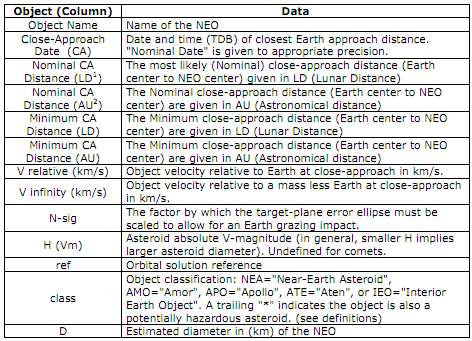Background Information
The National Aeronautics and Space Administration (NASA) is the agency within the United States Government responsible for US space exploration. Within the NASA there are programs not directly associated with manned space activity. One of the most recently funded initiatives is the tracking and monitoring of Near Earth Objects (NEOs).
NEOs are comets and asteroids that have been nudged by the gravitational attraction of nearby planets into orbits that allow them to enter the Earth's neighborhood.
Composed mostly of water ice with embedded dust particles, comets originally formed in the cold outer planetary system. The giant outer planets (Jupiter, Saturn, Uranus, and Neptune) formed from an agglomeration of billions of comets and the left over bits and pieces from this formation process are the comets we see today.
Likewise, today's asteroids are the bits and pieces left over from the initial agglomeration of the inner planets that include Mercury, Venus, Earth, and Mars. So most of the rocky asteroids formed in the warmer inner solar system between the orbits of Mars and Jupiter.
A new scientific interest in comets and asteroids is due to recent research indicating that an "event" (a NEO that may collide with the Earth) could likely occur anytime within the next few hundred years The Jet Propulsion Laboratory (JPL) located at California Institute of Technology (CalTech) near Pasadena, California, has been given the budget for the NEO program, although the program spans the entire globe and many scores of scientists.
The Project
You are a scientist at the JPL and you have been given project responsibility for analysis of NEOs for the purpose of developing an Early Warning System (EWS). You have an extract of the JPL NEO Database of 10,972 close-Earth approaches sorted by date, occurring on or after 2013-Feb-14 UT through 2200-Dec-24 UT. (Only those close approaches within 0.1 AU are included). This is actual NEO data from JPL; and we have extracted the data to a comma delimited text file (NEO.txt) file for ease of use.
The data elements in the extract (NEO.txt) are as follows:

1. (LD) Lunar Distance: 1.0 LD is about 3.84x10^5 km or 0.00257 AU (the average distance between the Earth and the Moon).
2. (AU) Astronomical distance Unit: 1.0 AU is about 1.5x10^8 km (roughly the average distance between the Earth and the Sun).
Some of the fields that are in the data extract will not be used in this Examination.
TASKS TO PERFORM PER SPECIFICATION
A. Define all methods, structs, classes, and any data file that you create or use including their relationships and attributes.
B. Develop System Flow Charts and functional flow charts of each function
C. Program your system entirely in ANSI C.